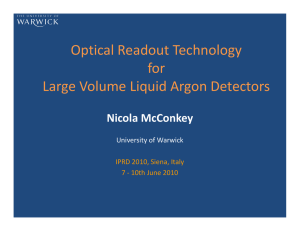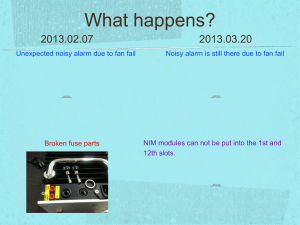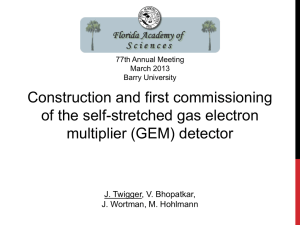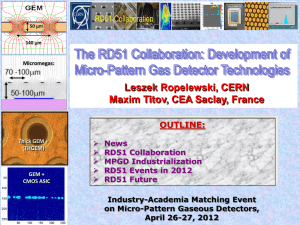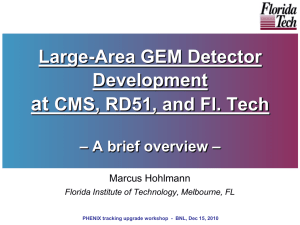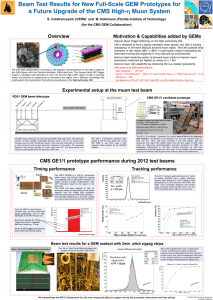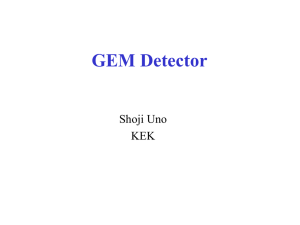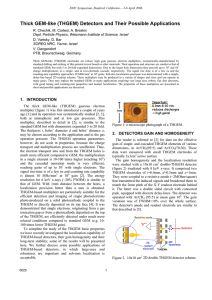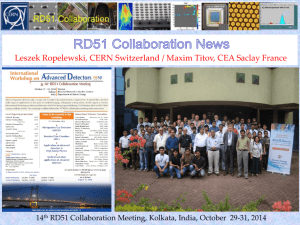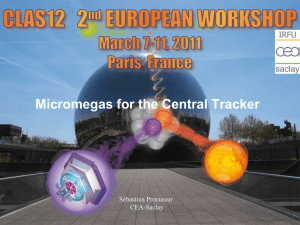Titov_GasDetTiming_FINAL_28042011
advertisement
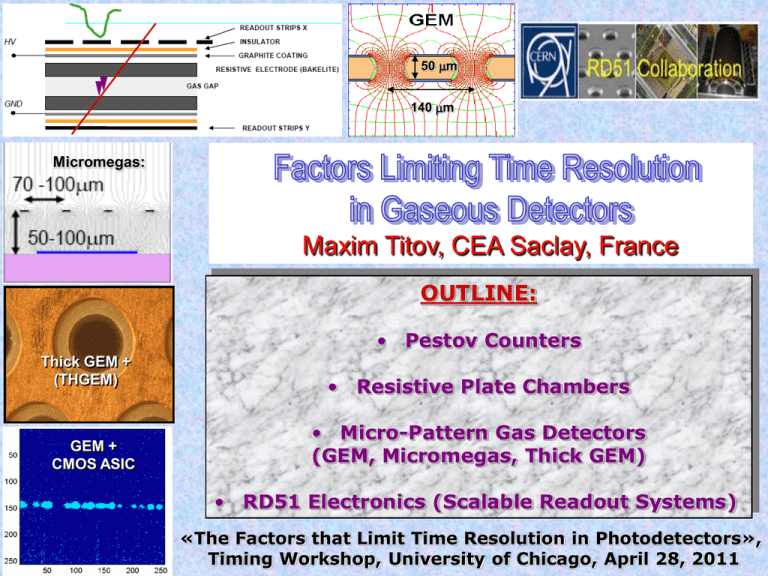
50 mm 140 mm Micromegas: Maxim Titov, CEA Saclay, France OUTLINE: • Pestov Counters Thick GEM + (THGEM) GEM + CMOS ASIC • Resistive Plate Chambers • Micro-Pattern Gas Detectors (GEM, Micromegas, Thick GEM) • RD51 Electronics (Scalable Readout Systems) «The Factors that Limit Time Resolution in Photodetectors», Timing Workshop, University of Chicago, April 28, 2011 Yu. Pestov, NIM 196(1982)45 GOOD TIME RESOLUTION ---> THIN GAP GOOD EFFICIENCY---> THICK GAS LAYER THIN GAP (100 µm) AND HIGH PRESSURES (~10 bar) HIGH RESISTIVITY ELECTRODE (PESTOV GLASS, 109 Ω cm PHYSICAL ORIGIN OF TAILS IN THE TIME RESPONSE OF SPARK COUNTERS: Yu Pestov et al. NIMA265 (1988) 198 Yu. Pestov et al., NIMA456 (2000) 11 Mangiarotti and A. Gobbi, NIMA. A482(2002)192 HIGH-PRESSURE GAS VESSEL METAL CATHODE SEMI-CONDUCTING GLASS ANODE SIGNAL PICK-UP STRIPS Time resolution is proportional to discharge delay time (fluctuation of delay time is the sum of the fluctuation of the avalanche development and the occurrence of the streamer) READOUT STRIPS X HV INSULATOR GRAPHITE COATING HIGH RESISTIVITY ELECTRODE (BAKELITE) GAS GAP GND R. Santonico, NIMA 187(1981)37 P. Fonte, NIMA449 (2000) 295 ; P.Fonte, A.Smirnitski, C Williams, NIMA443(2000)201 I.Crotty et al, NIM A337(1994)370 READOUT STRIPS Y Time resolution of a RPC can be parameterized as: Δτ = λ/v λ is the mean free path of electrons in avalanche, v is drift velocity of electrons LOW λ and HIGH v can be obtained with dense/fast gas mixtures: C2H2F4 – iC4H10 – SF6 Typical values: λ ~ 10μm, v ~ 100 μm/ns → Δτ ~ 100ps Only avalanches within a few hundred mm from cathode generate signals Raether limit: G = ed/λ < 108 → for λ ~ 10μm dgap ~ 200μm To avoid discharges the gap must be reduced → MICROGAP • INCREASING THE GAP PROVIDES BETTER EFFICIENCY PLATEAUX • For gas gaps of 0.3 mm or larger, the timing jitter in parallel-plate detectors varies almost linearly with the width of the gaps HV GND DOUBLE GAP FWHM=1.7 ns SINGLE GAP FWHM 2.3 ns M. Abbrescia et al, NIM A431(1999)413 (caveat - table last updated in 2003) Add boundaries that stop avalanche development. These boundaries must be invisible to the fast induced signal – induced signal on external pickup C. Williams, RD51 Mini-Week, July 20, 2010 Would like large fast signal and small total charge (high rate capability) (After time correction using pulse-height) HV FLOATING GND E. Cerron Zeballos et al, NIMA 374(1996)132 A. Akindinov et al, NIMA 456(2000)16 C. Williams, RD51 Mini-Week, July 20, 2010 Trigger RPC: R. Cardarelli, R. Santonico ATLAS, CMS (~ 2000 – 4000 m2) timing resolution ~ 1-5 ns (MIPs) X readout strips r ~ 1010 Wcm E ~ 50 kV 2 mm Bakelite 2 mm gas gap 2 mm Bakelite Y readout strips Timing and Multi-Gap RPC ALICE TOF P. Fonte, V. Peskov, C. Williams (~50 ps) Pickup electrodes 0.4 mm glass plates 0.3 mm gas gaps Pickup electrodes E ~ 100 kV `Renaissance of particle identification’ using Multi-Gap RPC in ALICE: B 10 ps devices could be feasible – one of the biggest problem could be the electronics : the TDC C. Williams, RD51 Mini-Week, July 20, 2010 • Micromegas 0.18 mm CMOS VLSI • GEM • Thick-GEM, Hole-Type Detectors and RETGEM • MPDG with CMOS pixel ASICs CMOS high density readout electronics • Ingrid Technology Ions 40 % 60 % Electrons Micromegas GEM THGEM MHSP Ingrid Thin metal-coated polymer foil chemically pierced by a high density of holes A difference of potentials of ~ 500V is I+ applied between the two GEM electrodes. The primary electrons released by the ionizing particle, drift towards the holes e- where the high electric field triggers the Induction gap electron multiplication process. eS1 S2 S3 S4 Electrons are collected on patterned readout board. A fast signal can be detected on the lower GEM electrode for triggering or energy discrimination. All readout electrodes are at ground potential. F. Sauli, Nucl. Instrum. Methods A386(1997)531 F. Sauli, http://www.cern.ch/GDD F. Sauli, NIM A386(1997) 531; F. Sauli, http://www.cern.ch/GDD Full decoupling of amplification stage (GEM) and readout stage (PCB, anode) Cartesian Compass, LHCb Small angle Amplification and readout structures can be optimized independently ! 33 cm Hexaboard, pads MICE Compass Totem NA49-future Mixed Totem Time-resolution is determined by the fluctuations in the photoelectron transit time from their emission point at the PC and, after multiplication, to the anode. depends on the detector geometry, the electric field conditions and properties of the gas composition, namely on the electron diffusion and drift velocity. Induction gap ~ 1mm Single Photon Time Resolution: low diffusion & CF4 high electron drift 770 torr velocity in CF4 Single Photon Position Accuracy: 200 µm Intrinsic accuracy s (RMS) ~ 55 µm FWHM ~160 µm Beam ~ 100 µm T. Meinschad et al, NIM A535 (2004) 324; D.Mormann et al., NIMA504 (2003) 93 Triple GEM for CMS Upgrade: Triple GEM for LHC-b Detector : Time Resolution ~ 5 ns Time resolution for different gas mixtures and gap configurations: • Ar(45):CO2 (15):CF4 (40) [gaps 3/1/2/1] • Ar(70):CO2(30) [gaps 3/2/2/2] G. Bencivenni, IEEE A. Bressan et al, TNS 49(6), 3242 (2002) Nucl. Instr. and Meth. A425 (1999) 262 A. Sharma, private communications Simple & Robust Manufactured by standard PCB techniques of precise drilling in G-10 (and other materials) and Cu etching STANDARD GEM 103 GAIN IN SINGLE GEM THGEM 105 gain in single-THGEM Other groups developed similar hole-multipliers: - Optimized GEM: L. Periale et al., NIM A478 (2002) 377. 1 mm 0.1 mm rim - LEM: P. Jeanneret, to prevent - PhD thesis, 2001. discharges C. Shalem et al, NIMA558 (2006) 475; Double THGEM or THGEM/Micromegas 1,0E+07 1,0E+06 1,0E+05 106 1,0E+04 Gain • Effective single-electron detection (high gas gain ~105 (>106) @ single (double) THGEM) • Few-ns RMS time resolution • Sub-mm position resolution • MHz/mm2 rate capability • Cryogenic operation: OK • Gas: molecular and noble gases • Pressure: 1mbar - few bar 1,0E+03 1,0E+02 1,0E+01 MM = 330 NeCF4 10% MM = 290 NeCF4 5% DTHGEM NeCF4 10% DTHGEM NeCF4 5% 1,0E+00 1,0E-01 1,0E-02 0 200 C. Azevedo et al.; arXiv: 0909.3191 400 600 DV THGEM (V) 800 1000 Signal shape is determined by the electron drift velocity and the width and field strength in the induction gap. • Smaller induction gap & Single photons Electron drift time from THGEM surface into holes (simulation) R. Alon et al., arXiv: 0809.4382 R. Alon, MsD 2007, Weinzmann Institute • Higher electric field Faster and narrower signals Time Resolution with MIPs: Variations in rise-time, shape and amplitude (in addition to statistics of primary ionization) Micromesh Gaseous Chamber: a micromesh supported by 50-100 mm insulating pillars Multiplication (up to 105 or more) takes place between the anode and the mesh and the charge is collected on the anode (one stage) Small gap: fast collection of ions Y. Giomataris et al, NIM A376(1996)29 Single photon pulse height distribution (Polya) CsI coated mesh Excellent S/N performance: Single Photon Time Resolution: Physical time jitters for UV photons electron diffusion in the gas and noise. Micromegas Time Resolution : s ~ 700 ps J. Derre et al., NIM A449 (2000) 314 The time information for each channel is extracted from the peak time of the ADC spectra. The strip with the earliest arrival time is taken as reference. A time resolution of ~1 ns results in space points with a resolution along the drift direction of ~50 μm T. Alexopoulos et al, NIM A617 (2010) 161 InGrid: integrate Micromegas & pixel chip by Si-wafer post-processing technology • Grid robustness & Gap/Hole accuracy Deposit 50 µm SU(8) UV Exposure 0.8 µm Al grid Pattern Al Development of SU8 photoresist “Ingrid” + Silicon Protection Layer: Apply Si3N4 (high resistivity layer 3-20 mm) for discharge quench & SPARK PROTECTION “InGrid” Detector: SiProt Layer before InGrid production M. Chefdeville et al, NIMA556(2006) 490 Observe electrons (~220) from an X-ray (5.9 keV) conversion one by one and count them in micro-TPC (6 cm drift) Provoke discharges by introducing small amount of Thorium in the Ar gas - Thorium decays to Radon 222 which emits 2 alphas of 6.3 & 6.8 MeV Study single electron response Round-shape images of discharges 1.5 cm Fe55 source P. Colas, RD51 Collab. Meet., Jun.16-17, 2009, WG2 Meeting M. Fransen, RD51 Collab. Meet., Oct.13-15, 2008, WG2 Meeting http://rd51-public.web.cern.ch/RD51-Public Collaboration of ~75 institutes worldwide, ~ 430 authors “RD51 aims at facilitating the development of advanced gas-avalanche detector technologies and associated electronic-readout systems, for applications in basic and applied research.” RD51 Collaboration Meetings: 1st - Amsterdam April 16-18, 2008 : http://indico.cern.ch/conferenceDisplay.py?confId=25069 2nd - Paris, October 13-15, 2008 : http://indico.cern.ch/conferenceDisplay.py?confId=35172 3rd - Crete (Greece), June 12-16, 2009 : http://candia.inp.demokritos.gr/mpgd2009/ 4th – CERN, November 23-25, 2009 : http://indicobeta.cern.ch/conferenceDisplay.py?confId=72610 5th – Freiburg, Germany, May 24-27, 2010 : http://indico.cern.ch/conferenceDisplay.py?confId=89325 6th – Bari (Italy), October 7-10, 2010: http://indico.cern.ch/conferenceDisplay.py?ovw=True&confId=102799 7th –CERN, April 12-15, 2011: https://indico.cern.ch/conferenceDisplay.py?confId=132080 22 Freiburg , Germany, May 2010 Bari, Italy, October 2010 GEM Consolidation around common projects: large area MPGD R&D, CERN/MPGD Production Facility, electronics developments, software tools, beam tests WG1: large area Micromegas, GEM; THGEM R&D; MM resistive anode readout (discharge protection); design and detector assembly optimization; large area readout electrodes and electronics interface WG2: double phase operation, radiation tolerance, discharge protection, rate effects, singleelectron response, avalanche fluctuations, photo detection with THGEM and GridPix WG3: applications beyond HEP, industrial applications (X-ray diffraction, homeland security) WG4: development of the software tools; microtracking; neBEM field solver, electroluminescence simulation tool, Penning transfers, GEM charging up; MM transparency and signal, MM discharges WG5: MPGD Scalable Readout System (SRS); Timepix multi-chip MPGD readout WG6: CERN MPGD Production Facility; industrialisation; TT Network WG7: RD51 test beam facility 23 Development of a portable multi-channel readout system: • Scalable readout architecture: a few hundreds to several thousand channels Suited for small test systems up to very large systems (> 100 k ch.) • Project specific part (ASIC) + common acquisition hardware and software • Scalability from small to large system • Common interface for replacing the chip frontend • Integration of proven and commercial solutions for a minimum of development • Default availability of a very robust and supported DAQ software package(DATE). DATE Root-based offline Analysis Contro l PC Trigger, clock and control Common Clock Data + Control Control SRU 40x DTC point-to-point links FEC 1000 BASE-SX up 500 m Multimode fiber (1 Gbit) 10 GBASE-SR up 300 m Multimode fiber ( 10 Gbit) 10 GBE GBE switch network (only for multi-SRU architectures) .... SRU .... 40x simultaneous data up 200Mbit/s per FEC. ... FEC FEC FEC FEC chip s chip s chip s chip s Chip link interface Application specific chip-carriers HLT GB-ethernet MM fiber or copper ethernet Specific TTC & Trigger Clock & timing fibers / CAT6 Readout Units LHC machine: GBE copper Test systems: DA Q Single mode fiber Online/ Offline … DETECTOR ADC frontend adapter for APV and Beetle chips ADC plugs into FEC to make a 6U readout unit for up to 2048 channels 18 ADC V1.0 produced in 2010 18 ADC V1.1 waiting for production 2011 FEC cards Frontend hybrids so far all based on APV25 chip Version 1 proto: 5 working Version 2 users: 11 Version 3 systems: 16 (CERN PCB + bonding workshops), 320 (ELTOS + Hybrid SA ) = ongoing Virtex-5 FPGA, Gb-Ethernet, DDR buffer, NIM and LVDS pulse I/O High speed Interface connectors to frontend adapter cards 22 FECs V1.1 produced in 2010 16 FEC V1.3 ready for production (all users booked) Industrial partners survey for the production For details please contact : hans.muller@cern.ch Detector Technology • Pestov Counter Typical time resolution* 30-50 (ps) (High pressure, streamer discharge mode) • Resitsive Plate Chambers (RPC) ~ 1-5 ns (MIPs) • MultiGap RPC ~ 50 ps (MIPs) • Gas Electron Multiplier ~ 1-2 ns - UV photons ~ 5-10 ns - MIPs • Micromesh Gaseous Structures - UV photons - MIPs ~ 700 ps ~ 1-10 ns * Numbers should be considered only as approximate
